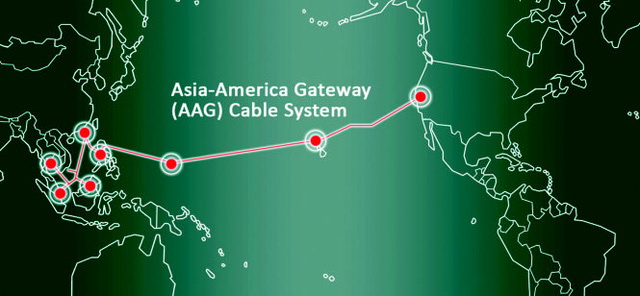If the Internet was likened to a house, submarine fiber optic cables are the ‘gateways’ that allow 24/7 connection to the world.
>> The Internet turns 20 in Vietnam: P6 – Wi-Fi and household Internet
>> The Internet turns 20 in Vietnam: P5 – The premier’s first email
>> The Internet turns 20 in Vietnam: P4 – National domain .vn
>> The Internet turns 20 in Vietnam – P3: The ‘semi-illegal’ era
>> The Internet turns 20 in Vietnam: P2 – Australian professor’s contribution
>> The Internet turns 20 in Vietnam: P1 – Forerunners
International underwater fiber optic cable systems currently dwarf Vietnam’s international connection output over land and by satellite.
The AAG – ‘the backbone’
Before 2009, Vietnam was completely reliant on its connection via two underwater Internet cable systems, namely the SMW3 (Southeast Asia - Middle East - Western Europe 3) and the TVH (Thailand-Vietnam-Hong Kong), both of which had limited capacity.
TVH had a design capacity of only 560Mbps in each direction, while that of the SMW3 was 320Gbps.
The remaining capacity was obtained via land-based connections.
The Asia-America Gateway (AAG) officially came into operation in November 2009 and quickly proved crucial to the country’s connectivity.
The AAG is a 20,000-kilometer submarine communication cable, connecting Southeast Asia with the U.S. mainland across the Pacific Ocean via Guam and Hawaii.
The AAG was designed with an initial capacity of 2Tbps (2,000Gbps) but has undergone multiple upgrades since.
Nguyen Huu Khanh, then-director of Vietnam Telecom International (VTI), under the Vietnam Posts and Telecommunications Group (VNPT), one of three major Internet service providers in Vietnam, said that the AAG launch was expected to meet the demands of Vietnamese users for bandwidth, particularly bandwidth-based services including video, data transmission and other multimedia services.
To out it in perspective, the AAG could support 130,000 high-definition television signal transmission lines simultaneously.
The system was also intended as backup for the others and a contingency in worst-case scenarios.
Subsequently, the TVH system was slated for ‘retirement’ in late 2009.
Also in November 2009, the Intra-Asia (IA) cable was put into operation with an initial total capacity of 320Gbps.
EVN Telecom, under the Electricity Group of Vietnam, which was forced to accept its acquisition by the military-run Viettel Group to avoid insolvency in 2013, was the only Vietnamese unit to join and was entitled to 50Gbps.
In late 2016, the Asia Pacific Gateway (APG) was completed, allowing for the highest Internet traffic capacity in Asia.
It was expected to offer Internet users in Vietnam a more reliable connection than the AAG system after repeated ruptures over the past several years.
The AAG, however, played an undeniably crucial role as an ‘artery’ that fostered the country’s Internet connectivity between 2010 and 2016.
Vietnam was home to 22.77 million Internet users in 2009, or 26.55 percent of the population, with the volume of international bandwidth slightly higher than 100Gbps, according to statistics by the Vietnam Internet Network Information Center (VNNIC).
That number had surged to 31.2 million by 2012, accounting for over 35.4 percent of the population.
The capacity has reached over 340Gbps at this time, exceeding the total volume of each link of both the SMW3 and IA.
Vietnam’s international bandwidth speed had topped 3.8Tbps by the end of 2016, 38 times higher than before the AAG was installed, with more than 60 percent of international connections going through the AAG.
 |
| Vietnamese workers are seen fixing a submarine optic fiber cable segment. Photo: VNPT |
Repeated ruptures
Internet traffic in Vietnam is heavily impacted whenever the AAG cable ruptures, as it has the largest capacity of the three current systems.
Since becoming operational in November 2009, the AAG has experienced repeated problems.
Internet service providers say they are used to the problems and all have backup plans to ensure continued connection for users.
Nguyen Van Khoa, general director of FPT Telecom, a major Internet service provider in Vietnam, told Tuoi Tre (Youth) newspaper that undersea cable systems are complicated and reliant on several elements including weather, marine traffic and seismic activity.
He confirmed that all three submarine cable systems had experienced problems.
Experts maintain that the East Vietnam Sea and Singaporean waters invariably experience hectic shipping activity.
High-capacity freighters are common, leaving the optic fiber cables at the mercy of anchor drops and drags.
Complicated weather patterns in the East Vietnam Sea, with a high frequency of typhoon activity, can result in storm surges and river discharges that also lead to problems.
The TVH cable breakage, for instance, caused significant damage and heavily affected outbound Internet connections in 2007.
The incident was blamed on residents’ theft of US$6.8 million worth of cable that was 11km long and weighed around 100 metric tons.
In case of ruptures, the control station in the affected area will locate the breakage and inform the system operators.
The cable system operator will contact a cable repair ship, which is a huge vessel, to book a repair date.
Upon receiving the command, the ship and the cable operator are expected to lodge an application to the government of the country or territory of the affected area and seek permission for access to make the necessary repairs.
It typically takes one day to pinpoint the rupture location, another day to make the appointment, and one week to seek government approval.
Depending on the location, the repair ship’s travel time could be anywhere up to three or four days.
The timeframe for repair will also be influenced if the sea is rough.
Following the location of the affected segments, divers will be sent into the sea to stabilize the breakage.
Robots will also be used to pincer the two ends of the broken cable segments and lift them aboard for welding.
It generally takes three to four days to finish the welding before the segments are reattached to the undersea cables.
In water up to100m deep, robots will carry the fixed segments back to the seafloor before reattaching and burying them.
After any incident, the average total timeframe for repair is between three and four weeks.
|
Why optic fiber cables? The latest addition to Vietnam’s network of international submarine optic fiber cables is the AAE-1 (Asia - Africa - Europe). The system connects every continent except Antarctica. Submarine optic fiber cables are the telecom cables laid on the seafloor which have glass or plastic core and make use of light to transmit data. The cables have multiple protective layers to ensure their safe operation. An average undersea optical fiber cable is 69mm in diameter and weighs an average of 10kg/m. |
Like us on Facebook or follow us on Twitter to get the latest news about Vietnam!



















































